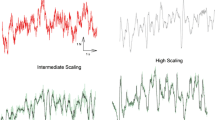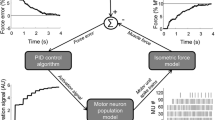Summary
In the previous study it was shown that cats were capable of making rapid and accurate adjustments in the force they applied to a lever in accord with information provided by a compensatory display. In the present study, isometric responses were examined in greater detail to determine 1. if a general control policy (or model) governing responses of different magnitudes could be inferred from the relations among output parameters and 2. if the earliest output measures were scaled to the preceding sensory events.
The force adjustments elicited by the sudden motion of the display showed a linear relation between the peak force and the peak of its first derivative, dF/dt. Similarly, the peak d2F/dt2 was a linear function of dF/dt. By contrast, the times required to achieve the peak force and the peak dF/dt were largely independent of their magnitudes. These adjustments were produced by a burst of EMG activity in agonist muscles which coincided with the rising phase of dF/dt. The observations suggest that such motor outputs are determined by a pulse-step control policy. The amplitude of the pulse would control the rate of rise of dF/dt (and therefore also the peak force since the rising phase of dF/dt was of constant duration), and the step would control the level of the terminal steady state force.
Both the peak force and the preceding peak dF/dt were highly correlated with the amplitude of the perturbation. Changes in display gain, which altered the required relation between input and output magnitudes, resulted in a gradual readjustment of the output parameters. It was concluded that the motor outputs were scaled from their inception to requirements dictated by the initial sensory information. The selection by the cat of the appropriate scaling function was contingent upon its previous experience with the device.
Similar content being viewed by others
References
Bahill, A.T., Clark, M.R., Stark, L.: The main sequence, a tool for studying human eye movements. Math Biosci 24, 191–204 (1975)
Buck, L.: The boundary distance effects on overshooting. J Mot Behavior 8, 35–41 (1976)
Büdingen, H.J., Freund, H.-J.: The relationship between the rate of rise of isometric tension and motor unit recruitment in a human forearm muscle. Pflügers Arch 362, 61–67 (1976)
Bouisset, S.: EMG and muscle force in normal muscle activities. In: New Developments in EMG and Clinical Neurophysiology, Vol. I (ed. J.E. Desmedt), pp. 547–583. Basel: Karger 1973
Burke, R.E., Rudomin, P.: Spinal neurons and synapses. In: Handbook of Physiology, Section I. The Nervous System, Vol. I (ed. J.M. Brookhart and V.B. Mountcastle), pp. 877–944 Washington: American Physiological Society 1977
Eccles, J.C., Eccles, R.M., Lundberg, A.: Synaptic actions of motor neurons caused by impulses in golgi tendon organ afferents. J Physiol (Lond) 138, 227–252 (1957)
Ghez, C., Vicario, D.: Isometric tracking in the cat. Soc Neurosci Abstracts 3, 271 (1977)
Ghez, C., Vicario, D.: Discharge of red nucleus neurons during voluntary muscle contraction: Activity patterns and correlations with isometric force. J Physiol (Paris) (in press) (1978a)
Ghez, C., Vicario, D.: The control of rapid limb movement in the cat. I. Response latency. Exp Brain Res 33, 173–179 (1978b)
Grillner, S.: The role of muscle stiffness in meeting the changing postural and locomotor requirements for force development by ankle extensors. Acta Physiol Scand 86, 92–108 (1972)
Houk, J.C., Singer, J.J., Henneman, E.: Adequate stimulus for tendon organs with observations on mechanics of ankle joint. J Neurophysiol 34, 1051–1065 (1971)
Nichols, T.R., Houk, J.C.: Improvement in linearity and regulation of stiffness that results from actions of stretch reflex. J Neurophysiol 39, 119–142 (1976)
Partridge, L.D.: Modification of neural output signals by muscles: A frequency response study. J Appl Physiol 20, 150–156 (1965)
Poulton, E.C.: Tracking skill and manual control. New York: Academic Press 1974
Rack, P.M.H., Westbury D.R.: The effects of length and stimulus rate on tension in the isometric cat soleus muscle. J Physiol (Lond) 204, 443–460 (1969)
Robinson, D.A.: The mechanics of human saccadic eye movement. J Physiol (Lond) 174, 245–264 (1964)
Robinson, D.A.: Oculomotor unit behavior in the monkey. J Neurophysiol 33, 393–404 (1970)
Robinson, D.A.: Models of the saccadic eye movement control system. Kybernetik 14, 71–83 (1973)
Smith, A.M., Hepp-Reymond, M.-C., Wyss, U.R.: Relation of activity in precentral cortical neurons to force and rate of force change during isometric contractions of finger muscles. Exp Brain Res 23, 315–332 (1975)
Soechting, J.F., Ranish, N.A., Palminteri, R., Terzuolo, C.A.: Changes in motor pattern following cerebellar and olivary lesions in the squirrel monkey. Brain Res 105, 21–44 (1976)
Tanji, J., Kalo, M.: Recruitment of motor units in voluntary contraction of a finger muscle in man. Exp Neurol 40, 759–770 (1973)
Welford, A.T.: Fundamentals of skill. London: Methuen 1968
Author information
Authors and Affiliations
Rights and permissions
About this article
Cite this article
Ghez, C., Vicario, D. The control of rapid limb movement in the cat II. Scaling of isometric force adjustments. Exp Brain Res 33, 191–202 (1978). https://doi.org/10.1007/BF00238059
Received:
Issue Date:
DOI: https://doi.org/10.1007/BF00238059




